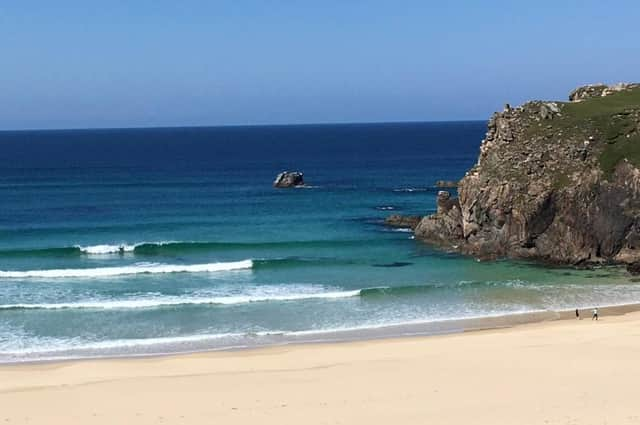For surfers on the Isle of Lewis, very good things come to those who wait


Given its exposure to pretty much any swell going in the North Atlantic, I suppose I must always have assumed that the Isle of Lewis would be a good surfing destination, but it wasn’t until 2006 that I realised how good. That was the year the National Theatre of Scotland celebrated its creation with a series of events all over Scotland, collectively titled Home, and I was dispatched by this newspaper to cover the Stornoway show – a brilliantly atmospheric performance in Gaelic and English, masterminded by Stuart Laing and set in a doll’s house in a shop window on Church Street.
Whether I managed to get myself sent to the only Home show taking place within striking distance of a surfable coastline by accident or design is anyone’s guess. Surfing must have been on my mind, though, because while I was in town I looked up local surfer and former fisherman Derek MacLeod, who at that time was running a surf school called Hebridean Surf Holidays. We met in the kitchen of the Sunset Restaurant in Stornoway – a business he also ran – and I remember seeing a picture of a very significant-looking wave taped to the side of the fridge.
“It gets quite big here,” he told me.
“How big?” I asked.
“Too big. Too big for us.”
“Bigger than double overhead [12ft waves]?”
Advertisement
Hide AdAdvertisement
Hide Ad“Och, we’re out in double overhead all the time. You get used to it after a while. Triple overhead is usual. It starts getting a bit hectic after that.”
In the decade and a half since meeting up with MacLeod, I've returned to Lewis several times with boards in tow, but somehow wind, swell and tide have never quite aligned. I've spent balmy, windless evenings at Barvas watching six-inch wavelets trickle over the famous cobblestones, and I've attempted to surf Cliff Beach on the Uig peninsular with the waves torn to shreds by both howling onshore and howling offshore winds. This summer though, finally, I managed to time things right.
Just to be clear, we're not talking hectic conditions a la MacLeod: the waves weren't triple overhead, double overhead or even plain overhead; more like shoulder-high. But perfection is in the eye of the beholder, and to a now middle-aged surfer, a little out of shape and graying around the temples, a clean, empty, modestly-sized wave that peels and peels until your thighs start to burn will do very nicely.
Considering its enormous surf potential – similar open ocean exposure to Cornwall but with less of a continental shelf to take the sting out of the waves – Lewis is still very much under the radar as a surf destination. Occasionally it will attract the attention of the world's surf media, as in September 2001, when three-time world champ Tom Curren visited to take part in the first International Hebridean Surf Festival, or in the winter of 2005/6, when Californian big wave specialist Rusty Long pitched up in an attempt to win the Billabong XXL prize for the biggest wave ridden that year. On the whole, though, the crowds in the water remain sparse.
That's not to say that there isn't still a small, thriving surf community on the island, however. A couple of years ago, the local artist and surfer Laura Maynard put on an exhibition of paintings at An Lanntair arts centre in Stornoway featuring 15 Lewis-based surfers alongside their favourite surf spots. She titled the show "Wave Migration" – a nod to the fact that many of the surfers on the island have moved there specifically for the waves – and she told me that the work grew out of her desire to “document this golden age, this little point in time.” Not too many surfers, but not too few either: a bit like Malibu in the 50s, only with beanies instead of bikinis, heather instead of palm trees, and little prospect of overcrowding ever causing the dream to sour.
It's certainly difficult to imagine the stunning white sand beach at Mangersta on the Uig peninsular ever getting crowded. This west-facing bay, with its high cliffs and dramatic sea stacks, is situated towards the end of a slow, undulating single-track road which terminates in a dead-end a little further down the coast, so it's not the kind of surf spot you can easily check on the way to somewhere else. On a four-foot west swell with light offshore winds, though, it's a lazy forty-something surfer's dream.
At high tide, a submerged rock formation at the northern end of the beach beneath the cliffs marks the take-off spot, so you never have to worry that you might be sitting in the wrong place, and from here the waves peel at a leisurely pace most of the way across the bay. Once you've made the surprisingly easy paddle-out, it's simply a case of lining yourself up with the rocks, waiting for a wave to roll in and then cruising through to the inside. You can make turns if you feel the need, but this is the kind of wave that encourages you to simply hang there and take in the view. Under different conditions, Mangersta could doubtless offer more white-knuckle thrills; if I could only surf it in its laid-back mood, though, I’d still keep coming back.
A message from the Editor:
Thank you for reading this article. We're more reliant on your support than ever as the shift in consumer habits brought about by coronavirus impacts our advertisers.
If you haven't already, please consider supporting our trusted, fact-checked journalism by taking out a digital subscription at https://www.scotsman.com/subscriptions